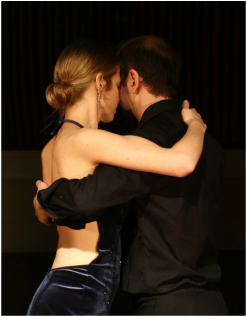Tango milonguero

Milonguero style is the most intimate close embrace style. It is danced in a very close embrace which is 'square on' on the closed side ie. with the woman's left side directly lined up with the man's right. There is very little 'v' on the open side - only enough to comfortably accommodate each partner's shoulder and arm.
The 'chest to chest' embrace never alters and is never broken. To achieve this, the main feature of milonguero style is that it is 'non-pivoting', so you will see smaller steps and more crossed positions from the follower. In place of individual disassociation or spiral, you will see the couple share complementary turns and pivots. Many salon steps are impossible in milonguero style, but some work perfectly. And because of the sustained closenesss, there is potential for 'apilado' (sharing the axis in a 'lean').
For this style to be comfortable and successful, each partner must bring sufficient 'presence' and groundedness to the embrace. Both leader and follower need to understand the different principles of milonguero style compared with the more familiar salon style: the basic crosses (front and back), and thus ochos and giros, are very different from those in salon.
Milonguero style should not be confused with 'milonga', which is an entirely different dance - a rhythmic variation within the tango family, danced to separate music (click here).
Learning milonguero style
Milonguero is rarely danced with great proficiency in a social context, yet with a little work and practice, it is incredibly rewarding for both leader and follower, and ideal for crowded dance floors.
It is rarely taught as a stand-alone style; instead, some of the easiest milonguero steps have found their way into salon tango (eg. the rather inaccurately-named 'ocho milonguero'). We are fortunate to have studied milonguero intensively and extensively with experts in this tradition.
We are unusual in offering dedicated milonguero style classes. We ensure that both leaders and followers grasp the basic principles of this style and its differences from salon. We focus on the quality of the shared embrace, and lead and follow. We teach all the basic movements you would need to dance an entire track in milonguero style. We also show how to move between this and salon. These classes are available to experienced improvers, intermediates and advanced.
To dance like this takes a lot of practice, but it is really quite extraordinary, and gives a sensation of closeness between partners that is unparalleled; we love to dance in this way with each other.
It is rarely taught as a stand-alone style; instead, some of the easiest milonguero steps have found their way into salon tango (eg. the rather inaccurately-named 'ocho milonguero'). We are fortunate to have studied milonguero intensively and extensively with experts in this tradition.
We are unusual in offering dedicated milonguero style classes. We ensure that both leaders and followers grasp the basic principles of this style and its differences from salon. We focus on the quality of the shared embrace, and lead and follow. We teach all the basic movements you would need to dance an entire track in milonguero style. We also show how to move between this and salon. These classes are available to experienced improvers, intermediates and advanced.
To dance like this takes a lot of practice, but it is really quite extraordinary, and gives a sensation of closeness between partners that is unparalleled; we love to dance in this way with each other.
Footnote: the myth and origins of milonguero style
Milonguero style tango is often claimed to be the 'oldest' style of authentic tango, though it is highly unlikely that this is true. But one can see why the myth appeals: this style of tango is danced in the closest of embraces, is attentive to the music - especially its rhythmic qualities, and uses a limited repertoire of steps. It exhibits a beautiful simplicity and purity of form, and is all about the couple sharing their tango, not a performance for onlookers. It thus crystallises some of the essential qualities of Argentine tango.
Tango milonguero is still danced in Argentina, especially in the long-established venues, though our own experience of dancing in Buenos Aires suggests that, contrary to some claims, most social dancers there dance salon style in a close, intimate but flexible hold.
Milonguero style was rejuvenated in the 1990s, when tango as a whole was transformed by the nuevo revolution (click here). It was already danced by social dancers who wished to mark their tango as distinct from the tango show dancing being exported across the world; in the 1990s, milonguero style was refined, the footwork tidied and updated, and clear-cut principles were established. This is the version we teach.
(NB: American websites often erroneously use the term 'milonguero style' to refer to close-embrace salon tango.)
Tango milonguero is still danced in Argentina, especially in the long-established venues, though our own experience of dancing in Buenos Aires suggests that, contrary to some claims, most social dancers there dance salon style in a close, intimate but flexible hold.
Milonguero style was rejuvenated in the 1990s, when tango as a whole was transformed by the nuevo revolution (click here). It was already danced by social dancers who wished to mark their tango as distinct from the tango show dancing being exported across the world; in the 1990s, milonguero style was refined, the footwork tidied and updated, and clear-cut principles were established. This is the version we teach.
(NB: American websites often erroneously use the term 'milonguero style' to refer to close-embrace salon tango.)
Read about other authentic tango styles by clicking below:
Page updated 7th December 2014